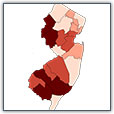View by year
2016

Where Should Online Peer-to-Peer Markets Thrive?
The rapid growth of firms such as Uber, Airbnb, and Task Rabbit has attracted considerable attention – and controversy – from the media, policymakers and researchers.
DOI: https://doi.org/10.17016/2380-7172.1894

A Look Under the Hood: How Banks Use Credit Default Swaps
The credit default swap (CDS) market is often regarded as one of the most influential financial market innovations to occur in the past 20 years.
DOI: https://doi.org/10.17016/2380-7172.1865

Import Penetration and Domestic Innovation: A View into Dynamic Gains from Trade
In this paper, we revisit the link between innovation activity, measured by the number of patent applications, and import flows.
DOI: https://doi.org/10.17016/2380-7172.1892

Inflation Perceptions and Inflation Expectations
Given the presumed role of inflation expectations in influencing actual inflation, it is important to understand the implications of the survey expectations and whether differences from official estimates contain an important signal.
DOI: https://doi.org/10.17016/2380-7172.1882

Prices and Depreciation in the Market for Tablet Computers
Spurred by advances in electronic miniaturization and power efficiency, lightweight, powerful and inexpensive tablet computers entered the mass market in significant volumes in 2010. Since that time, sales of tablet computers have increased to account for over half of personal computer (PC) units sold worldwide.
DOI: https://doi.org/10.17016/2380-7172.1885

The Effect of Hurricane Matthew on Consumer Spending
Severe weather events, such as blizzards and hurricanes, can temporarily disrupt economic activity. The imprints of these events on aggregate statistics can make it challenging for macroeconomists to analyze and forecast economic conditions.
DOI: https://doi.org/10.17016/2380-7172.1888

Holiday Spending and Financing Decisions in the 2015 Survey of Household Economics and Decisionmaking
One of the recurring themes in the Federal Reserve Board's Survey of Household Economics and Decisionmaking (SHED) is a lack of savings capacity for many individuals.
DOI: https://doi.org/10.17016/2380-7172.1866

The Neutral Rate and the Summary of Economic Projections
This note uses information provided in the quarterly Summary of Economic Projections (SEP) of Federal Open Market Committee (FOMC) meeting participants to extract estimates of the neutral federal funds rate--defined as the value of the federal funds rate that is "neither expansionary nor contractionary if the economy were operating near its potential"--in the short and longer run.
DOI: https://doi.org/10.17016/2380-7172.1890

The Tools and Transmission of Federal Reserve Monetary Policy in the 1920s
This note describes the tools used by the Federal Reserve (Fed) to implement monetary policy in the 1920s and the degree to which changes in these tools were transmitted to private money markets.
DOI: https://doi.org/10.17016/2380-7172.1871

Front-End Term Premiums in Federal Funds Futures Rates and Implied Probabilities of Future Rate Hikes
In this note, we examine empirical evidence on term premiums at the very front end, utilizing federal funds futures data as well as responses to the Desk's sell-side survey (Survey of Primary Dealers, or PD survey) and buy-side survey (Survey of Market Participants), and discuss plausible front-end term premium assumptions that one can use to extract probabilities of a rate hike at upcoming meetings from market quotes.
DOI: https://doi.org/10.17016/2380-7172.1884

"Limited Attention" and Inflation Expectations of Households
In this note, we use the household-level data in the University of Michigan's Surveys of Consumers, including respondents' own changes in expectations, to document new signs that households pay limited attention to inflation developments.
DOI: https://doi.org/10.17016/2380-7172.1830

Updating the Recession Risk and the Excess Bond Premium
Beginning with the publication of this Note, we will provide updated estimates of the EBP and the associated model-implied probability of a U.S. recession every month.
DOI: https://doi.org/10.17016/2380-7172.1836

Changing FHA Mortgage Insurance Premiums and the Effects on Lending
To what extent can the cost of credit affect home buying and mortgage borrowing activity?
DOI: http://dx.doi.org/10.17016/2380-7172.1843

Credit Availability and the Decline in Mortgage Lending to Minorities after the Housing Boom
This note sheds light on the factors contributing to the disproportionate decline in lending to minorities since 2006.
DOI: http://dx.doi.org/10.17016/2380-7172.1842

Inflation Expectations in the Recovery from the Great Depression
In this note, we draw on our recent research on the role of inflation expectations in the recovery from the Great Depression of the 1930s (Jalil and Rua, 2016a and 2016b) to provide insights into the actions that can successfully shift inflation expectations and stimulate economic recovery.
DOI: http://dx.doi.org/10.17016/2380-7172.1831

Maternity Leave and the Gender Wage Gap: An Analysis of New Jersey Family Leave Insurance
Women, on average, are paid less than men. According to the 2015 report prepared by the Institute for Women's Policy Research (IWPR), female full-time workers in the United States received only 81 cents for every dollar earned by men; this difference amounts to a gender wage gap of 19 percent.
DOI: http://dx.doi.org/10.17016/2380-7172.1817

Funding Agreement-Backed Securities in the Enhanced Financial Accounts
This note describes new data on funding agreement-backed securities (FABS) that is being provided as part of the Enhanced Financial Accounts (EFA) initiative.
DOI: http://dx.doi.org/10.17016/2380-7172.1823

International Portfolio Investment Holdings of Long-term Securities in the Enhanced Financial Accounts
This note and associated website provide new detail on international portfolio investment holdings of long-term securities, as part of the Enhanced Financial Accounts (EFA) initiative.
DOI: http://dx.doi.org/10.17016/2380-7172.1814

Which market indicators best forecast recessions?
In this note, we use econometric methods to infer which economic and financial indicators reliably identify and predict recessions.
DOI: http://dx.doi.org/10.17016/2380-7172.1805

Has Tax-Preferred Retirement Saving Offset Rising Wealth Concentration?
The share of wealth owned by top wealth-holders in the U.S. has been rising over the past few decades, though there is some debate about exactly how concentrated wealth is, and how fast those top wealth shares are rising.
DOI: http://dx.doi.org/10.17016/2380-7172.1811

The Role of Social Security in Overall Retirement Resources: A Distributional Perspective
In this note, we first present trends in participation in employment-related retirement plans, and then provide analysis for one birth cohort, nearing retirement age, of the impact of Social Security on retirement wealth.
DOI: http://dx.doi.org/10.17016/2380-7172.1812

Bank Complexity: Is Size Everything?
Can we measure the complexity of large banks by comparing their balance sheets?
DOI: http://dx.doi.org/10.17016/2380-7172.1802

Findings on Relative Deprivation from the Survey of Household Economics and Decisionmaking
The Federal Reserve's Survey of Household Economics and Decisionmaking (SHED) contains questions designed to ascertain overall economic well-being and fragility, which can be used to gauge both the perceptions individuals have about their own economic status and an approximation of their actual financial health.
DOI: http://dx.doi.org/10.17016/2380-7172.1791
The Young and the Carless? The Demographics of New Vehicle Purchases
A number of recent studies and press articles have documented a dramatic decline in young adults' willingness to own vehicles, particularly in the years since the 2007-09 recession.
DOI: http://dx.doi.org/10.17016/2380-7172.1798

A Cautionary Note on the Help Wanted Online Data
Measuring labor demand is one of the crucial tasks in analyzing the labor market.
DOI: http://dx.doi.org/10.17016/2380-7172.1795

Macroeconomic Sources of Recent Interest Rate Fluctuations
The authors use a new statistical method to attribute daily changes in U.S. Treasury yields and inflation compensation to changes in investor beliefs about domestic and foreign growth, inflation, and monetary policy.
DOI: http://dx.doi.org/10.17016/2380-7172.1777

Macroeconomic Modeling of Financial Frictions for Macroprudential Policymaking: A Review of Pressing Challenges
Structural macroeconomic modeling plays a central role economic policy discussions.
DOI: http://dx.doi.org/10.17016/2380-7172.1785

Corporate Bond Issuers' Swap Exposure to Rising Interest Rates
United States corporate bond issuance has been elevated in recent years relative to historical standards, reflecting in part accommodative financing conditions at historically low rates.
DOI: http://dx.doi.org/10.17016/2380-7172.1776

Is Underemployment Underestimated? Evidence from Panel Data
Despite a broad recovery of the U.S. economy from the depths of the Great Recession, lingering slack remains in the labor market.
DOI: http://dx.doi.org/10.17016/2380-7172.1775

Where do I see the Monetary Policy Normalization Tools on the Fed's Balance Sheet and Income Statement?
On December 16, 2015, the Federal Open Market Committee (FOMC) determined it was appropriate to raise the effective federal funds rate from the 0 to 25 basis point range it had been set at since late 2008. This note highlights where some of the key elements of the FOMC's approach to policy normalization are reported on the Federal Reserve's website.
DOI: http://dx.doi.org/10.17016/2380-7172.1764

The Role of Global Supply Chains in the Transmission of Shocks: Firm-Level Evidence from the 2011 Tōhoku Earthquake
The April 2016 Kumamoto earthquake in southwest Japan has sent ripple effects through global supply chains. Toyota, Honda and Sony halted most Japanese production following the quake, and more recently General Motors announced production stoppages at four North American plants, citing parts shortages. Such far-reaching consequences of natural disasters are not without precedent.
DOI: http://dx.doi.org/10.17016/2380-7172.1765

Government-Backed Mortgage Insurance Promoted a Speedier Recovery from the Great Recession
The United Sates government has a long history of involvement in mortgage finance. During the 1930s, the government created the Federal Home Loan Banks (FHLB), the Federal Housing Administration (FHA), and the Federal National Mortgage Association (Fannie Mae).
DOI: http://dx.doi.org/10.17016/2380-7172.1742

Recession Risk and the Excess Bond Premium
Corporate bond spreads and the slope of the Treasury yield curve (that is, the term spread) are two financial indicators that are especially informative about the likelihood of an economic downturn over a medium-term horizon.
DOI: http://dx.doi.org/10.17016/2380-7172.1739

Has the inflation risk premium fallen? Is it now negative?
Inflation compensation is widely used by market commentators to gauge the expectations of investors regarding the outlook for inflation.
DOI: http://dx.doi.org/10.17016/2380-7172.1720

Corporate Equities by Issuer in the Financial Accounts of the United States
This FEDS Note shows how we report the value of corporate equities outstanding in the Financial Accounts and describes how we estimate each of its components.
DOI: http://dx.doi.org/10.17016/2380-7172.1731

Do People Leave Money on the Table? Evidence from Joint Mortgage Applications and the Minimum FICO Rule
There is mounting evidence that households make suboptimal savings and investment decisions.
DOI: http://dx.doi.org/10.17016/2380-7172.1718

Unraveling the Oil Conundrum: Productivity Improvements and Cost Declines in the U.S. Shale Oil Industry
Why have large declines in oil prices and in the rig count not triggered a more dramatic decline in production? At what price level would a large share of U.S. shale oil production lose economic viability?
DOI: http://dx.doi.org/10.17016/2380-7172.1736

History of the Federal Reserve Board Statistical Releases
In this note, we describe the history of the Federal Reserve Board statistical publications presented in FEDS Paper 2016-016.
DOI: http://dx.doi.org/10.17016/2380-7172.1721

Funding Agreement-Backed Securities in the Financial Accounts of the United States
This note describes a new method of accounting for funding agreement-backed securities (FABS) in the Financial Accounts of the United States.
DOI: http://dx.doi.org/10.17016/2380-7172.1696

Annual Data on Investment and Capital Stocks
As part of the estimation of capacity for publication of its G.17 statistical release on industrial production and capacity utilization, the Federal Reserve Board produces annual information on the real capital stock and real investment for detailed industries within the manufacturing sector.
DOI: http://dx.doi.org/10.17016/2380-7172.1717

What Happened in Money Markets after the Fed's December Rate Increase?
At its December 2015 meeting, the Fed's policymaking committee, the Federal Open Market Committee (FOMC), announced an increase in the target range for the federal funds rate of 25 basis points, the first increase in the policy rate since June 2006.
DOI: http://dx.doi.org/10.17016/2380-7172.1713

The Risk of Returning to the Effective Lower Bound: An Implication for Inflation Dynamics after Lift-Off
In this note, we analyze an implication of the effective lower bound (ELB) risk--the possibility that adverse shocks will force policymakers in the future to lower the policy rate to the ELB--on inflation dynamics after liftoff.
DOI: http://dx.doi.org/10.17016/2380-7172.1690

The Federal Reserve's New Approach to Raising Interest Rates
At its December 2015 meeting, the Federal Open Market Committee (FOMC)--the Federal Reserve's monetary policy committee--raised its target range for the federal funds rate by 25 basis points, marking the end of an extraordinary seven-year period during which the federal funds target range was held near zero to support the recovery of the U.S. economy from the worst financial crisis and recession since the Great Depression.
DOI: http://dx.doi.org/10.17016/2380-7172.1706

The Expected Real Interest Rate in the Long Run: Time Series Evidence with the Effective Lower Bound
In response to the global financial crisis, the Federal Open Market Committee lowered the target for the federal funds rate to a range of 0 to 25 basis points in December 2008, and maintained that target range until the end of 2015. Over that same period, longer-term interest rates in the United States were at historically low levels.
DOI: http://dx.doi.org/10.17016/2380-7172.1703

State and Local Pension Funding in the Enhanced Financial Accounts
In this Note we describe new state-level data on the funding status of state and local government defined-benefit pension plans, which is part of the Enhanced Financial Accounts (EFA) initiative.
DOI: http://dx.doi.org/10.17016/2380-7172.1700

Saving for College and Section 529 Plans
The past decade has simultaneously witnessed a substantial increase in enrollment at post-secondary institutions and a marked increase in college tuition. Not surprisingly, this trend overlapped with an increased demand for student loans and tax-advantaged educational savings.
DOI: http://dx.doi.org/10.17016/2380-7172.1684
Disclaimer: FEDS Notes are articles in which Board staff offer their own views and present analysis on a range of topics in economics and finance. These articles are shorter and less technically oriented than FEDS Working Papers and IFDP papers.